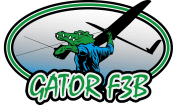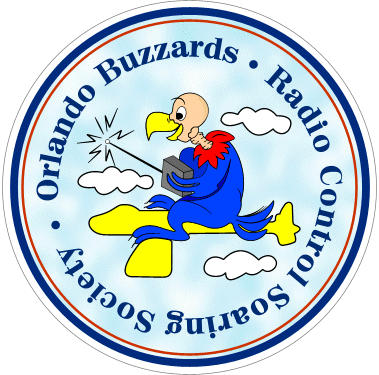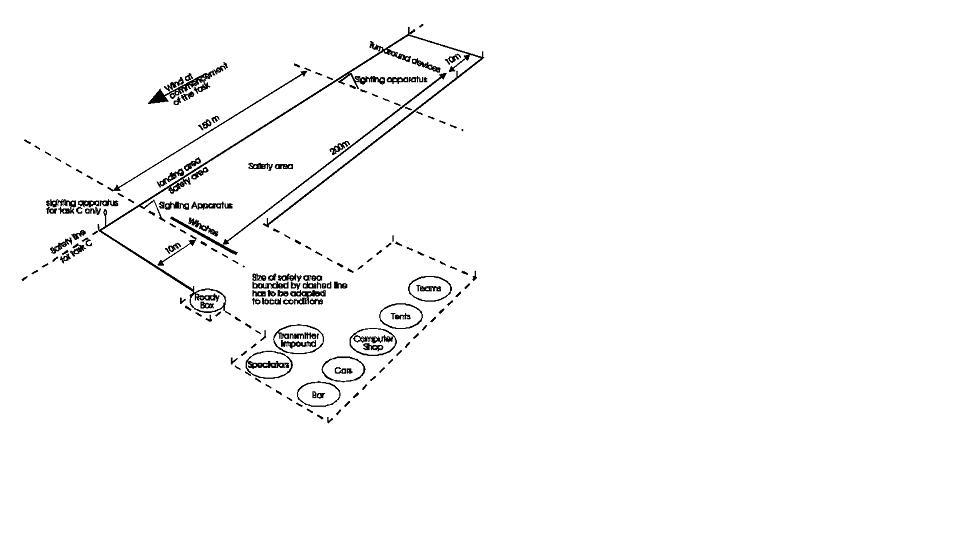“All you ever wanted to know about F3B, but did not dare ask..”
Why three tasks ?
The concept of F3B was invented in the 1970’s by Ferdinando Gale (now aged 80), an Italian aeronautic engineer, at a time when FAI did not know of a valid competition class for model gliders. In those times, some competitions ran a aerobatics glider category that did not attract much interest. Ferdi thought it might be nice to have a competition where the same radio controlled model glider would be checked for performance in three pretty different conditions, roughly corresponding to the three most characteristic points of the “polar”, the name given to the theoretical curve representing the speed-versus-sink-speed of a glider.
Three characteristic points on the polar
Least sink speed is one of these points, for which the “duration” task has been created. The primary property being tested is the ability to remain in the air for a prolonged time. Note that this test of model performance can be really valid only in perfectly still air, conditions which are very rarely found outdoors, especially overday.
The second characteristic point on a polar curve of a glider is the “best glide ratio”, an expression of how far a glider can reach from a given altitude. This is in principle the most important characteristic of a glider, as it is a measure of how well the aircraft can transform its potential energy (which depends on its altitude above the ground) into the distance it can travel before reaching ground level. To check this property, the “distance” task was invented.
The third characteristic point on a given polar is the maximum speed. While it could in principle be limited only by the adverse effects of drag, the maximal speed a glider can reach is more frequently limited by the maximal stress its structure can withstand. To check this point, the “speed” task was designed.
Ferdi proposed to fly the three tasks during the same round of a contest, with the same model, the only changes allowed being ballasting the glider according to the circumstances. For distance and speed, the field would be equipped with devices to define two parallel vertical planes distant 150 meters, and both distance and speed would be measured between these planes. For duration, an additional constraint was introduced, namely the precision landing.
All these ideas were out around 1975, when the first set of F3B rules was accepted by the CIAM. Numerous international contests were run according to them and by 1977, the class was recognized for World Championships.
Over the years, the rules changed progressively, first by removing the concept of maximum in distance (initally 12 laps…). Later on, the speed task went from two laps to four laps, making the task much more demanding. The maximum time in duration was successively raised from 6 to 7 minutes, and later to 10 minutes. This last move makes the duration task really demanding in neutral air conditions.
The power race came to an end
During all the first F3B contests, towing was made only by hand, which could be demanding in light air conditions. Old timers will remember memorable tow sequences by Geoff Dallimer, among others…;-). With the acceptance of electric winches that were to replace hand towing, the race to arms was started. It culminated during the 1981 championship in Sacramento-USA, where many gliders, notably the Canadians, did not sustain the adverse effects produced by overpowered winches, notably the Canadian so-called “King-Kong” winch. This which succeeded in getting so much initial speed for the model that after release from the tow ring, the model would still climb during the first two laps of the distance task… More frequently, the wings were stripped off the fuselage during the tow and the fuselage ended several hundred meter away after a perfect ballistic trajectory. This race to arms came to an end with the invention of the standard winch concept. Motor and battery are limited so that the issue of having the best winch on the field is no longer essential. Model conceptors concentrated on more noble means to reach the best possible performance. Today the best gliders on the fields are remarkable technological objects where all aerodynamic properties are optimized at an exceptional level. Models are completely molded from modern composite materials (epoxy resins, kevlar, glass and carbon fibre, etc.).
The pilot is still essential…
F3B accomplishes a beautiful balance between utmost technology refinements and highly talented piloting skills.
A reasonable pilot equipped with an exceptional model will not reach the mid of the classification. An exceptional pilot will probably not be able to bring his mid-of-the-road glider to high rankings. The top competitors are those who combine excellent model and towing technology with highly qualified piloting skills. And among these skills, one of the most important is the ability th “read the air”, i.e. to be able to identify at every moment where the local atmosphere is likely to deliver the best performance. As both distance and duration are flown in groups, the tactical aspects are also of great importance, and the best pilots will frequently be part of efficient and experienced teams.
The standard F3B winch
After the errements of unlimited and oversize winch contraptions, and a short period where bungee launches also became abusive, and thus outlawed, came the dark age of the “weak link”. This segment of standard nylon monofilament provided by the organizer was to be present on every tow line, be it hand tow or power winch, in order to disallow excessive towing forces. The line would break under a traction exceeding 40 kg… unless the unavoidable knots did prematurely surrender… ! This rule raged for a couple of years and turned most competitors mad. But it definitely prevented abusive towing procedures.
There was to be a better solution. It turned out to be the standardized F3B winch. This device was extensively studied by engineer and former world champion Ralf Decker and formalized in the rules during the mid 80’s. The electric motor had to present an internal resistance, when measured under precise conditions, of no more than 15 milliohm, while the cold cranking capacity of the battery had to be no more than 275 Amperes DIN. Line length between turnaround pulley and tow ring must be no more than 200 meters. A few other details like the imposed device to prevent line unwinding during the tow completed the definition of the standard winch that was one of the main elements in favour of the present popularity of the category. To reach good results, the accent must be on design and aerodynamic qualities of the model combined with excellent piloting skills.
Last year, the definition of the winch was revised with the goal to simplify its measurement on the field (overall resistance of circuit to be more than 23 milliohm and battery less than 300 ampere DIN). This rule will be used for the first time at a world championship this year. Everybody hopes for the best…
The flying field
The flying field is designed around a rectangle delimited at the ends by the sighting devices that materialise the two virtual planes distant 150 meters. These planes are designated as “base A” and “base B”. The winches are set up along a line parallel to base A, in the direction of base B, and this direction should be upwind. The turnaround pulleys are stuck to the ground 200 meters upwind from the winches line.
Besides the part of the filed devoted to measuring tasks B and C, several circles are set up somewhere alongside, where the precision landings of task A are going to take place. Recent field setups during major competitions allowed placing winches both in the direction of base B as in the opposite direction. This allows for reasonable launches if the wind happens to turn during the day. Competitors are in principle allowed to launch on either side, but the B and C tasks have always to be flown over the same ground setup.
The area where the speed flights have to be completed is materialised by the so-called “safety line” which materialised a vertical plane on one side of which all personnel has to remain, while the flight is happening completely on the other side. This takes care of the safety during this task where the gliders are known to reach speeds in the 200 km/h ballpark.
The three tasks
Duration Task A
The duration task is flown in groups of as many models as practically possible, generally around six at a time. This task has to be completed during a “working time” of 13 minutes. The goal is to reach as close as possible to an exact 10 minutes flight, between the time the towhook is released and the time the model comes to rest, preferably close to the predesignated landing spot. Any time or distance from the spot discrepancy is penalized. Within each group, the top scorer gets 1000 points, and all the opponents get the calculated pro-mille of the points of the winner.
Duration task is a pretty tactical task, where the pilots and his helpers has permanently to take into account a wealth of parameters, notably
• where is the opposition presently flying and how well are they doing
• where does the pilots and his helpers believe the air is potentially the best, judged from wind stength and shifts, temperature changes, sun and shadow areas, nature of the ground and the eventual field irregularities, etc.
• how long and where should he try to stay up in order to reach the time and landing goals
It is not exceptional that all pilots within a group reach the time goal within seconds, and are scored apart based on the precision of the landing. In still air, the task is really challenging, while in thermal air, the tactics become crucial.
Distance Task B
The distance task is also flown in groups, occasionally up to six models simultaneously.
The working time is 7 minutes. During this period, the pilot has to fly as many laps as possible, a lap being the distance between the bases. The time to fly these laps is limited for each pilot to a total of 4 minutes.
The precise time of the release of the model is each pilot’s decision. He may even decide to abort an ongoing flight, land and restart for another try. Only the last scored flight is taken into account. Tactics in distance are of paramount importance. The best scores are reached in thermal air where lap counts in the upper 20’s can be reached.
Like in duration, the best score within a group obtains 1000 points and the opposition the pro-mille fraction of it.
Speed Task C
The speed task is flown one by one. Each pilot has to complete 4 laps between bases A and B in as short a time as possible. After the release from the towhook, the pilot must enter the flight course within the first minute. Failure to do so invalidates the flight. Repeated towings are allowed, but the scored flight must be terminated before the end of the 4 minutes working time. The total time to complete the four laps is taken into account, so that turns must be as fast and as short as possible.
In large competitions the panel of pilots is divided in a few groups, so that significant changes in weather conditions do not affect too much the individual scores.
The best times in speed can be as short as 14 seconds, while lousy times are anything significantly over 20 seconds.
Final score
The final score for each pilot is the sum of all scores calculated during all tasks that were flown, unless the contest reached at least six complete rounds. In this case, the final score is computed after dropping the worst score of each pilot for each of the three tasks.
Our contact address :
Paulette Halleux email
Last updated on March 15, 2009 R.H.


